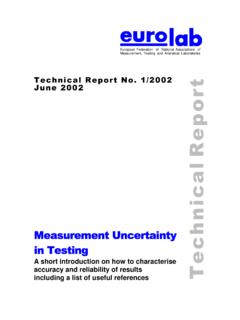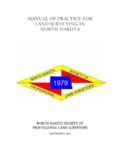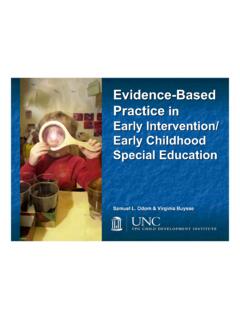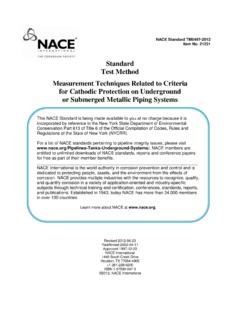Transcription of GUIDELINES ON THE ACOUSTICS OF SOUND FIELD …
1 NOTE Although care has been taken in preparing the information supplied by the British Society of Audiology, the BSA does not and cannot guarantee the interpretation and application of it. The BSA cannot be held responsible for any errors or omissions and accepts no liability whatsoever for any loss or damage howsoever arising. This document supersedes any previous recommended procedure of this Society British Society of Audiology (BSA), February 2008 GUIDELINES ON THE ACOUSTICS OF SOUND FIELD AUDIOMETRY IN CLINICAL AUDIOLOGICAL APPLICATIONS 1. Definition 2. Purpose and scope of this document Unaided hearing assessments Aided hearing assessments 3. Information from International Standards ISO 389-7 (2005) and ISO 8253-2 (1998) Type of SOUND FIELD Type of test signal Reference zero for equipment calibration 4.
2 Practical issues to consider in SOUND FIELD audiometry Purpose of measurements and accuracy required The available test environment The measurement scale to be used The use of hand-held SOUND generators Calibration of test stimuli Static (loudspeaker) SOUND sources Hand-held SOUND generators 5. Symbols and presentation of results 6. Appendices Appendix 1: Maximum permissible ambient SOUND pressure levels Appendix 2: Reference zero Appendix 3: Factors for conversion of dB(A) to dB HL 7. References 1. DEFINITION SOUND FIELD audiometry is a procedure to assess the hearing sensitivity of a person in which acoustic signals are presented through one or more SOUND sources in a room ( not through earphones).
3 2. PURPOSE AND SCOPE OF THIS DOCUMENT This document is intended to provide practical GUIDELINES and highlight some theoretical considerations for the implementation of SOUND FIELD audiometry for routine clinical assessment of hearing, using tonal or narrow-band noise stimuli. It does not cover the use of speech, speech-like, or speech-feature stimuli. It is not intended as a recommended procedure , but does provide suggestions on a range of issues in order to encourage consistent practice and reporting that is comparable between test centres. There are two main areas of application of SOUND FIELD audiometry in clinical audiology: Unaided hearing assessments In most cases SOUND FIELD assessment of hearing is applicable to young children and clinics in which learning disabled adults are tested. It is generally accepted that, once a hearing loss has been identified, it is preferable to determine frequency-specific unaided thresholds using supra-aural or (preferably) insert phones where possible, as this provides more accurate control of stimulus level as well as enabling ear-specific measures.
4 However, this is often not possible with young children and the principal aim of this document is to suggest ways to minimize some of the errors inherent in SOUND FIELD testing and to clarify some issues around interpretation of results. Unaided threshold measurements (minimal response levels) may be undertaken in various ways, but predominantly by: (a) Hand-held audiometer, usually with the signal-generating circuitry and a single loudspeaker in the same unit (most often used in a distraction test procedure). (b) Static systems, usually with separate signal-generating circuitry and one or more loudspeakers (most often used in visual reinforcement audiometry). Aided hearing assessments in hearing-aid users of all ages These are usually undertaken with a static system as in section and have historically been used to provide a measure of the aided hearing of the user, or the functional gain of the user's hearing aid(s).
5 This function has largely been replaced by real ear measurement except in the case of special devices, such as bone-anchored hearing aids or cochlear implants, where such measures are not possible. SOUND FIELD measures are not recommended for precise measurement of hearing aid performance for fitting purposes where information about the supra-threshold performance of the aid is required. Caution should be applied in making direct comparison between PTA results using supra-aural or insert earphones and SOUND FIELD aided thresholds obtained using narrow band stimuli. Often, different dB scales will apply and the actual SPL at the eardrum may vary considerably as a result of acoustic and anatomical factors. 3. INFORMATION FROM RELEVANT INTERNATIONAL STANDARDS Two international standards are most relevant: ISO 8253-2 (1998) defines test stimuli and SOUND FIELD characteristics for SOUND FIELD audiometry, describes calibration and maintenance procedures for equipment, and gives brief notes about test procedures and the display of results.
6 ISO 389-7 (2005) gives normative data (RETSPLs) for pure tones in a free SOUND FIELD and one-third octave band noise in a diffuse SOUND FIELD . Type of SOUND FIELD ISO 8253-2 (1998) describes three types of SOUND FIELD which are defined by the allowable variation of SOUND pressure level, produced by the output of a loudspeaker, in a small space surrounding a reference point. The reference point is roughly at the midpoint of the head of a hypothetical listener and is defined as: "The midpoint of a straight line connecting the listener's ear canal openings when positioned in the listening position in the SOUND FIELD ." In a free SOUND FIELD the walls, ceiling and floor exert a negligible effect on the SOUND waves produced by a loudspeaker in the room. This condition is met only in an anechoic room and is unlikely to be available in a clinical environment.
7 In a diffuse SOUND FIELD the walls, ceiling and floor exert a substantial effect on the SOUND waves produced by a loudspeaker in the room. The SOUND energy is uniform over a defined region. This condition is usually met only in a room which is designed to be highly reverberant and is unlikely to be available in a clinical environment. In a quasi-free SOUND FIELD the walls, ceiling and floor exert only a moderate effect on the SOUND waves produced by a loudspeaker in the room and is the condition most likely to be achieved, in practice, for the purpose of clinical threshold measurements. The SOUND FIELD is influenced by room reverberation and by the inverse square law with respect to the distance between the SOUND source and the reference point. To ensure that measurements are satisfactorily consistent and repeatable, the requirements specified by ISO 8253-2 must be closely adhered to: The loudspeaker should be at head-height of the seated listener, and directed towards the reference point.
8 The distance from loudspeaker to reference point should be at least 1 m in order to minimise the effects of the inverse square law near the reference point. In the absence of the test subject and chair the SOUND pressure levels m above, below and to the left and right of the reference point should not deviate from that at the reference point by more than 2 dB. In addition, the levels m in front and behind the reference point should not vary by more than 1 dB from those predicted by the inverse square law. The room should have low ambient noise. ISO 8253-2 specifies maximum permissible ambient SOUND pressure levels for hearing threshold level measurements down to 0 dB HL. However, these levels are difficult to achieve and, for practical purposes, it is reasonable to accept ambient SOUND pressure levels that are adequate for measuring hearing threshold level measurements down to 10 dB HL.
9 This entails adding 10 dB to the specified maximum permissible ambient SOUND pressure levels in (see also Lutman, 1997). These levels are given in Appendix 1. Type of test signal ISO 8253-2 (1998) defines three types of test signals which may be used in SOUND FIELD audiometry: pure tones frequency-modulated tones (often referred to as warble tones) narrow-band noise In a quasi-free SOUND FIELD , which is the condition most likely to be found in clinical conditions, only frequency-modulated tones and narrow-band noise should be used. Pure tones will cause marked standing waves, resulting in unpredictable and unacceptable fluctuations in SOUND pressure level within the room. ISO 8253-2 (1998) gives specifications for frequency-modulated tones and narrow-band noise which refer to specifications in IEC 225, IEC 645-1 and ISO 266. Any audiometer which is used for SOUND FIELD audiometry should comply with IEC 225 and IEC 645-1, but users must satisfy themselves that the additional requirements in ISO 8253-2 (1998) are also met.
10 Reference zero for equipment calibration ISO 389-7 (2005) provides reference hearing thresholds (RETSPLs) for calibration purposes, derived from a large group of laboratory studies in different countries. Reference thresholds are provided for the following two specific conditions and are reproduced in Appendix 2: pure tones heard binaurally under free- FIELD conditions with the subject facing the SOUND source one-third octave bands of noise heard binaurally in a diffuse SOUND FIELD Correction factors are provided by ISO 8253-2 (1998) for the increase in SOUND pressure at the ear closest to the loudspeaker when the SOUND is incident from 45o or 90o and are reproduced in Appendix 3. These may be required in some test situations but not others (see section ). Standard ISO 8253-2 (1998) provides GUIDELINES on calibration procedures. These are covered in detail in section 4.








